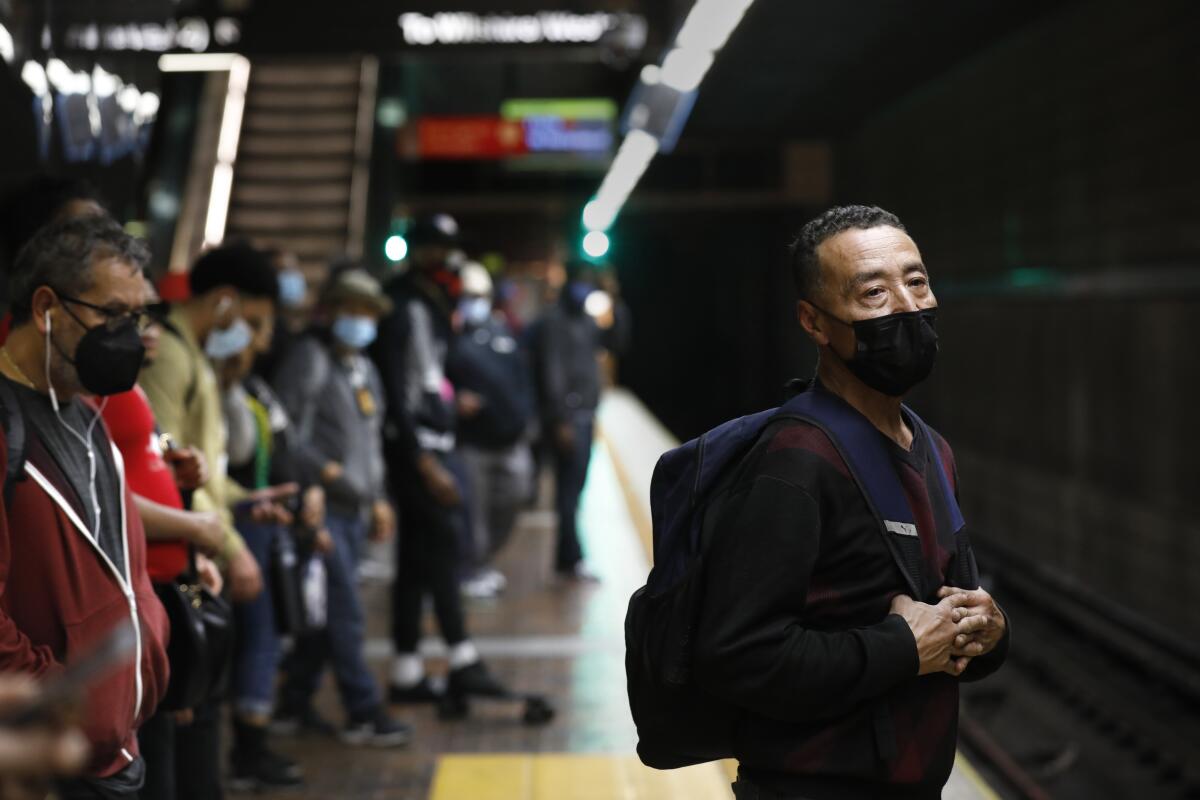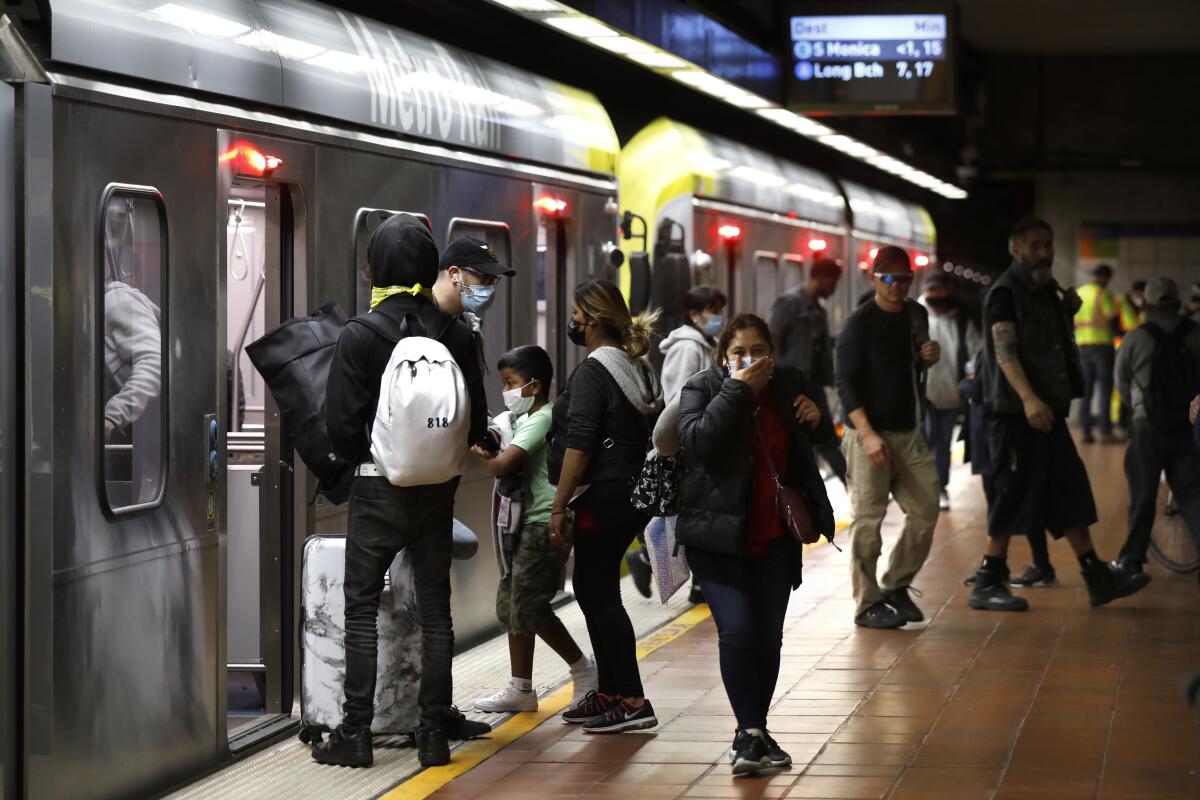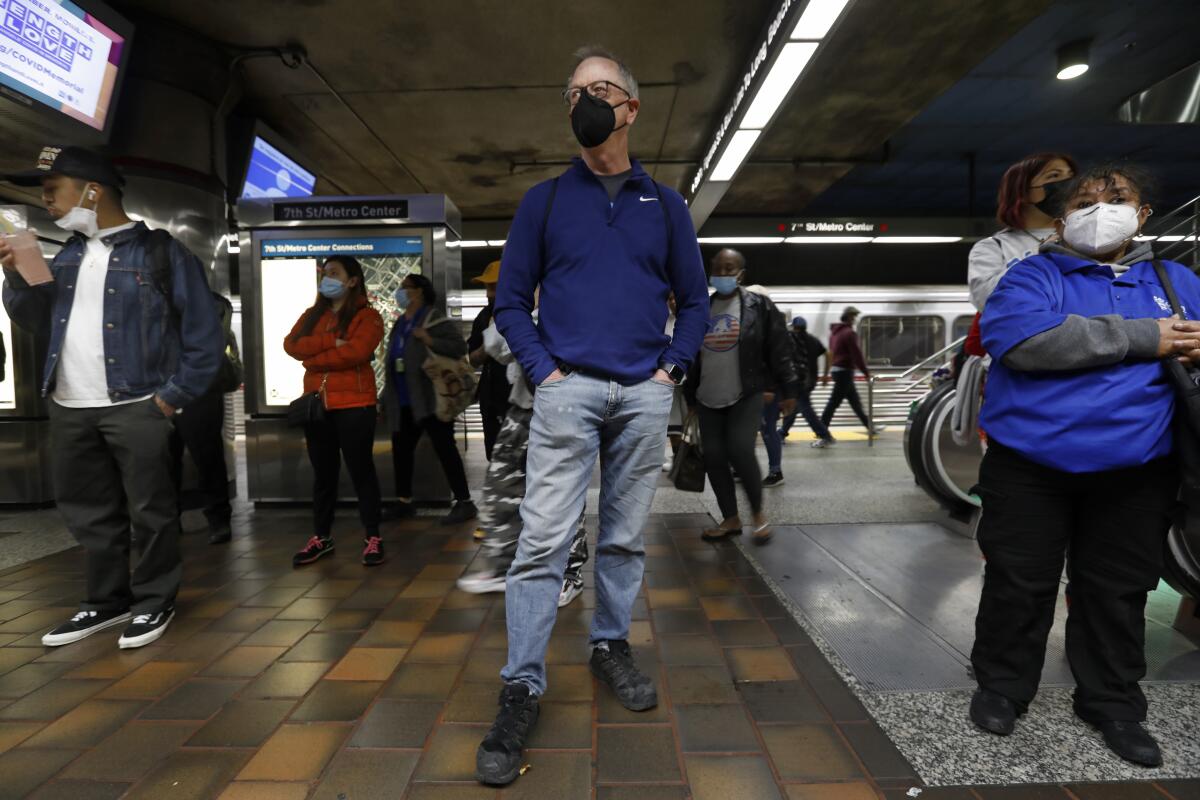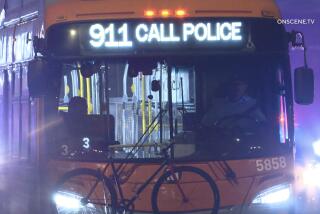Even with soaring gas prices, safety concerns make L.A. mass transit a hard sell

- Share via
Justin Moreau drives to his home in Norwalk from his night shift downtown, calculating how long he can go before enduring the pain of filling the tank of his 2008 Suzuki.
The security officer had already cut out leisurely trips when he bought the car last fall and was pondering how high prices would have to go before he would take the Metro bus or train for transportation.
“I’ve been thinking about that, trying to figure out what the thresholds are going to be,” said Moreau, who was paying about $5.50 a gallon “I think I will be OK at 50 cents more.”
If there was ever a time for Moreau, a once self-proclaimed Metro advocate, to return to mass transit, it’s now.
Gasoline prices have reached a record high in Los Angeles, while Metro has temporarily cut unlimited daily fares in half to $3.50 and monthly passes to $50 in a bid to attract more riders.

Metro said it’s too early to tell whether bus or train ridership is up, but Southern California’s commuter rail system, Metrolink, recorded its biggest weekly jump since the pandemic began, with 8% more riders boarding. The last time gas prices hit a record in 2008, the American Public Transportation Assn. reported a 4% bump in ridership from the previous year across the United States.
“Ridership should be going up,” said Los Angeles County Supervisor Hilda Solis, who is also chair of the Metropolitan Transportation Authority Board of Directors. “Every time gas spikes up so unreasonably, people do jump open.”
But luring back the 38-year-old Moreau, as well as convincing tens of thousands of other Angelenos to leave their gas guzzlers at home, is still a hard sell.
Metro slashed its bus and rail service this year amid a COVID-fueled driver shortage, leaving passengers waiting longer at stations and stops even as ridership began to bounce back from pandemic lows. Violent crimes on the system jumped 36% last year, according to Metropolitan Transportation Authority data. Aggravated assaults, rapes and even homicides rose for the second year in a row. Homeless people loitering on the subway have contributed to rising cases of harassment of riders and in some cases violence.

In 2021, through September, reports of violent crimes were up 25% from the same time last year and 9% from 2019, according to L.A. County Metropolitan Transportation Authority data. Some crimes, such as aggravated assaults, are exceeding pre-pandemic levels.
Moreau was proud that for 20 years he relied on Metro, but last summer after two rowdy men stalked him at the Willowbrook/Rosa Parks station he bought a car. “I felt my safety was in danger. And that was the last straw,” he said. “I was always a Metro advocate. I took pride in taking Metro. All my friends thought I was crazy. But I was proud of the fact that I would show up on time everywhere on the Metro until recently.”
At the Memorial Park station in Pasadena and at Union Station this week, several passengers said gas prices drove them to take Metro more frequently. At $1.75 a trip, Metro train and bus fare is a bargain. But many were worried about safety. Train cars at Union Station were filled with homeless people. One man bounced up and down talking to himself. Another rifled through three dirty bags as he mumbled.
Jolithia Collins, 33, takes the L Line to Chinatown, but she avoids the B train (formerly Red Line), a favorite among homeless men and women who can ride for long stretches in a quiet, warm place. “It’s more intense,” she said. “You see other people being assaulted and you see people get pushed.”

Grappling with the hundreds of homeless people who use the rail system for shelter and the increase in crime, Metro set aside $40 million for safety measures including adding elevator attendants for passengers, an emergency button for riders and uniformed personnel to respond to people with mental health emergencies. It’s a much softer approach than in New York City, where last month Mayor Eric Adams laid out a zero-tolerance approach for those sleeping or acting unruly on subways or in stations.
“We’re gonna have ambassadors and we’re gonna have also our public safety folks out there ... checking and making sure that people that need to be on the system are on the system and those that need help to get off because they’re homeless that they’ve been given appropriate services,” Solis said. “I think those fears will go away once we have more ridership come in.”
The insecurity some riders feel has a had a ripple effect through the system. Metrolink Chief Executive Darren Kettle said commuter train riders are increasingly “concerned” when they get to Union Station and transfer to Metro routes.
“We want to bring people back into public transit, but it’s got to be safe. People need to feel safe,” he said.

Riders say the system took a turn during the depths of the pandemic, when Metro lost about 70% of its ridership. Fares were lifted for a time, and homeless people became a larger presence as commuters stayed home.
Ridership has returned to 65% of pre-pandemic levels, with much of that due to the increase of bus riders, who often don’t own cars.
The majority of bus riders, 62%, have median household incomes under $20,000 and are people of color. That’s in stark contrast to Metrolink, whose riders in 2018, 39% of whom were white, had a median household income of $92,832.
Subway and bus ridership collapsed during COVID, and it’s likely to come back very slowly.
The jump in gas prices could prove to be a litmus test for Metro and mass transit in general. Transit planners have long argued that the cheap cost of driving vehicles keeps commuters from jumping on a bus or train, said Juan Matute, deputy director of the UCLA Institute of Transportation Studies.
“If driving gets 50% more expensive because of the increase in gas prices and you’re not seeing corresponding increase in ridership, maybe there’s something you got to look at about their service, improving it, whether it be reliability, safety or passenger information experience,” he said.
Many agencies promote “dump the pump” campaigns by offering lower fares as incentives, he said. On its Facebook page on Monday, Metro posted an image of a fuel price sign. But instead of numbers, it read “Arm, Leg, Both.”
“High gas prices hitting you hard? Go Metro instead with our discounted passes that let you ride all that you want!” the post said. Hundreds shared and liked the message, but it also became a place for frustrated riders to rant about the service cuts, homeless people and security.
“Right!” a user named Alexander Castro replied. “Because the only thing Metro asks in return is your time! Good luck going to work and trying to run some errands on the same day with bus service that takes forever to show up!”
Metro’s system has long taken a back seat in a region known for its freeway culture. But it will need to turn around those opinions to meet its ambitions as a serious alternative to the car. The $8-billion budget is Metro’s biggest ever, and the agency is on a massive construction spree with several rail projects including the Purple Line connecting downtown to the Westside and the Crenshaw/LAX Line set to open by the 2028 Olympics. Several more projects to make the system interconnected are in the pipeline.
“We do want everyone to start feeling safe so that they can go on trips on the weekend, go from the Gold Line in Azusa, all the way to Santa Monica Beach,” Solis said.
Transportation is the second-highest expense for American families after housing.
Angelina Stone, 61, started taking Metro daily — two buses and the L Line from her home in Pacoima to her office in Pasadena — after spending more than $100 a week filling up the gas tank. It’s not ideal, but she’s making it work.
“You see more fights, you see more people complaining, more people with mental health issues. You see people defecating or urinating in the hallways,” she said. “You have to do what you have to do to survive.”
Moreau said for now, he will stay in his car.
“When I am looking at the clock on my dashboard, I’m thinking I’d be waiting at the train right now,” he said. “I am just relieved. I get home in 18 minutes. It used to take me two hours. But if gas gets too high, I just couldn’t pay for it.”
More to Read
Sign up for Essential California
The most important California stories and recommendations in your inbox every morning.
You may occasionally receive promotional content from the Los Angeles Times.













